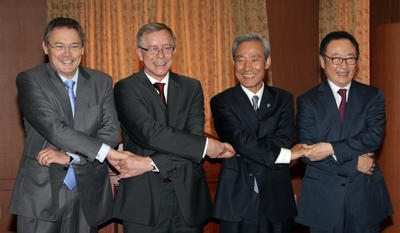Multilateral trade liberalisation through the WTO remains a preferred route for the EU. However, it now regards deep-integration FTAs as providing greater scope for liberalisation of behind-the-border non-tariff trade barriers (NTBs) on goods, services and investment. The GATT trade liberalisation rules on behind-the-border NTBs remain less specific than on tariffs and other border measures impacting on trade. The current EU policy on FTAs is spelled out in the EU’s 2006 Global Europe strategy.
In 2010, South Korea became the first country to conclude such a new-generation FTA with the EU. Similar FTAs with Canada and Singapore (as a possible step toward an ASEAN-wide agreement) are now in the pipeline and the EU is about to open deep-integration FTA negotiations with Japan. The Global Europe strategy is an interesting development, as deep-integration FTAs according to the EU model could, as they evolve, open the door to new modalities for liberalising regulatory barriers to international trade. Such modalities might contribute to widening the scope for more effective plurilateral and multilateral negotiations through the WTO on these issues.
However, another aspect of EU external relations sets FTAs concluded with the EU apart. The EU’s 2007 Treaty of Lisbon, which entered into force in 2009, modified the 1992 Treaty on European Union (better known as the Maastricht Treaty). Consequently, this Treaty now specifies that the external relations policy of the EU shall be ‘guided by the principles which inspired its own creation, development and enlargement, and which it seeks to advance in the wider world: democracy, the rule of law … human rights and fundamental freedoms’ and inter alia, among others, good governance, democracy, environmental protection, combating organised crime and anti-terrorism. The Treaty of Lisbon further provides that the ‘Common Commercial Policy’ of the EU, including FTAs, shall be guided by these principles. In other words, the Lisbon Treaty requires EU institutions to link agreements about international trade and investment with non-economic issues.
So, in the negotiations with South Korea, the deep-integration FTA was negotiated primarily by the European Commission’s Directorate-General for Trade, reflecting the supranational authority that the Commission has for EU-wide trade policy. These negotiations were concluded in 2009. The EU’s new European External Action Service then negotiated an overarching ‘framework treaty’ with South Korea. This agreement encompasses the broad range of ‘soft power’ foreign- and security-policy objectives required by the Lisbon Treaty, but which largely remain the responsibility of individual EU member states, as members have not handed supranational authority over these issues to the EU. These negotiations were completed in 2010. The negotiated agreements were then rolled together into a package, in which the FTA is an integral part of the overarching ‘framework treaty’.
Therefore, in the case of South Korea, the smooth functioning of the FTA is subject to respect for the provisions of the overarching bilateral framework treaty. This is not necessarily a problem given the laudable aims of the soft power foreign- and security-policy objectives espoused by the Lisbon Treaty and articulated in the bilateral framework treaty with South Korea, as well as South Korea’s ambition of being the ‘global hub’ of free trade and FTAs. However, it does make the implementation of the trade commitments in the FTA subject to respect for the EU’s broader foreign-policy objectives. This subjugation is topped off with the penalty clause in Article 45 of the EU–South Korea framework agreement.
This is a new element in international FTA negotiations; an attempt to use trade liberalisation to enforce respect for foreign-policy objectives has not previously been pursued in FTA negotiations. This is what makes the EU’s interest in FTAs in Asia — and beyond — special.
It appears that the EU is seeking to achieve the same objective in its current negotiations with Canada. It will presumably also seek to do so with Singapore and Japan. Negotiations on the EU–Canada FTA — the Comprehensive Economic and Trade Agreement (CETA) — are expected to wrap up this year. The EU is now also negotiating a framework treaty with Canada — the Strategic Partnership Agreement — to accommodate the provisions of the Treaty of Lisbon. It will be interesting to see how the EU and Canada will resolve this ‘linkage’ issue. Even though Canada no doubt shares the good governance principles that guided the ‘creation, development and enlargement’ of the EU, it may not be prepared to agree to the smooth functioning of the CETA being subject to perceived respect for broader EU international policy objectives.
The conclusion of the EU–Canada discussions, which is expected to will occur in the very near future, is likely to be closely watched by the other countries in line to negotiate treaty-level agreements with the EU: Singapore, Japan and Australia.
Don Kenyon is Associate Professor at the Centre for European Studies, the Australian National University.
Pierre van der Eng is Associate Professor at the Crawford School for Public Policy, the Australian National University.

